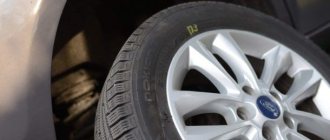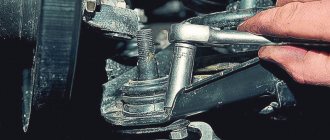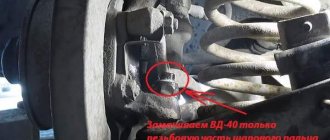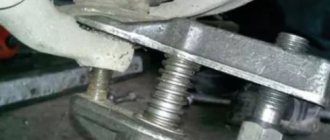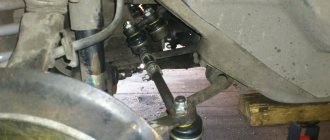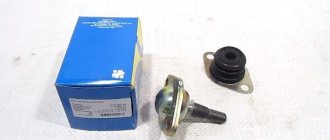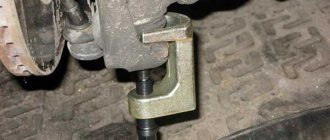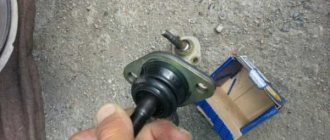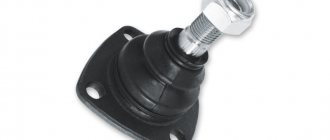As ball lubricants supports and steering tips most often use lithium-based lubricants because they are the cheapest, and its performance is quite sufficient for normal operating conditions (at temperatures from -40°C to +90°C). And the main requirements for the smear for these units are viscosity - NLGI 2, water resistance and temperature resistance. The most popular and cheapest lubricants for ball joints are the domestic ones “Litol 24” and “Ciatim 201”. They are suitable for almost any car, both domestic and imported models.
Progress does not stand still and, in addition to the old time-tested lubricants that our grandfathers used for ball joints, steering ends and stabilizer struts, more advanced compounds are being invented that can improve the effect on the hinge joint. Liqui Moly, Motul, Molykote, Amalie and some others are on their heels, but could they come up with the best lubricants for ball joints? The conclusion is in the ranking table of the best and their detailed review.
Table of the best ball lubricants
| Ball grease | Brief description and characteristics | Package volume, ml | Price as of summer 2022, Russian rubles |
| Litol 24 | The cheapest universal lubricant. Does not wash off with water, but has a bad effect on rubber, recommended for silicone anthers | Varies, depends on the manufacturer | from 70 rubles per 100 ml. |
| ShRB-4 | The best domestic barium-based lubricant for ball joints. | 500 | 180 |
| Liqui Moly Thermoflex Spezialfett | Provides absolute protection against corrosion. Has a high price. | 370 | 2600 |
| Amalie Elixir Green Synthetic Calcium Sulfonate Grease | Special lubricant for working with hinges. Works in difficult conditions. Low temperature range. | 425 | 750 |
| Motul Tech Grease 300 | A universal remedy. Average performance. | 400 | 530 |
| Ciatim 201 | It has the lowest temperature threshold -60°C and is washed off with water. | Varies, depends on the manufacturer. | from 220 rubles for 800 ml. |
| Molykote PG-65 | A universal product with good characteristics. The main disadvantage is the very high price. | 1 kg | 6200 |
How to lubricate ball joints
Various extraneous noises that irritate the driver when driving often have the same cause - insufficiently lubricated ball joints (BJ). Should we treat this as an unfortunate inevitability, or is it better to lubricate the supports? Each driver decides for himself, but there are proven recommendations based on practical experience. It is preferable to follow them if you do not want to spend extra money due to problems with such an important car part as ball joints.
To lubricate or not?
Do ball joints need to be lubricated before installation and during operation? To give the correct answer, it is worth understanding the principle of construction of any of these supports. It can be designed in different ways, but it must have a ball joint, as well as a pin. The base serves to support the hinge; the boot covers the support on top.
During operation, the hinge constantly shifts, which contributes to its rapid wear. In addition, dirt often accumulates in the empty space between the base and the boot, which interferes with the operation of the part. An alarming sign in this case is the appearance of knocks and creaks. To prevent this from happening, the space under the boot must be completely filled with auto-lubricant. It is very important to know what is the best way to lubricate ball joints for the most durable operation.
How to lubricate ball joints
How to lubricate the ball joint before installation? The most common options are:
Among lithium auto lubricants, Litol-24 and CIATIM-201 are popular. They contain oil and lithium soap in different proportions, and they also differ in the composition of additional additives.
The stabilizing substances present in Litol-24 ensure good preservation of the hinge and low lubricant consumption during its operation. However, this auto lubricant does not tolerate low temperatures well. CIATIM-201 stabilizes SHO to a lesser extent, but it better protects them from frost, and is cheaper.
Expensive lithium-calcium and calcium lubricants (various types of Shell Gadus, Grease Calcium, etc.) are recommended for increased loads on parts, as well as when they operate under extreme temperature conditions.
So what kind of lubricant should you use to lubricate ball joints? This depends on the following factors:
Based on these factors, for the average driver who operates his passenger car on asphalt roads in the middle zone, lithium auto lubricants are best suited as an acceptable compromise of price and quality. While in extreme conditions calcium and plastic lithium-calcium greases are more suitable.
When to lubricate ball joints
The SHO must be lubricated before installation at the factory. However, in some cases, especially when it comes to “domestic-assembled” machines, this requirement may not be met. In addition, displacement of the hinge during vehicle operation leads to lubricant consumption. The amount of lubricant decreases and during downtime, it dries out. That is why it is recommended to add lubricant not only during installation, but also periodically, after a certain period of operation. But how do you determine when a part needs to be re-lubricated?
All SB malfunctions can be easily identified by ear in the early stages, although modern diagnostics may be required in the future. The first warning sign for the driver is knocking and squeaking while driving. If they are heard precisely in those places where the SHO is located, then this particular node must be checked first of all. If there is no noticeable play, timely updating of the auto-lubrication will be a sufficient measure.
Experience shows that if one ball starts knocking, it is better to lubricate them all, since they have the same service life.
How to lubricate ball joints
How to lubricate ball joints yourself? On most modern car models, SHO lubricant is produced using a special syringe. The price of this tool is low and quickly pays for itself when you consider the cost of the parts that its use protects. In this case, the lubrication procedure is extremely simple and does not require not only special skills, but even basic drill skills. However, this process is not so easy in all cases.
On a number of cars, the inside of the SHO is not accessible with just a syringe. This means that you will have to cut the missing threaded fragments into parts. Here you can’t do without a drill and an appropriate attachment for carving metal. Another necessary tool for this is a regular bench vise to fix the removed part. However, there is nothing here that the car owner could not do on his own, at home.
Even if it is possible to lubricate ball joints directly on the car body, it is usually not recommended to do so due to the fact that it is a dirty job and can stain the body. On each specific car model, removing ball joints has its own characteristics, but the general principle is the same everywhere. It is quite possible to remove the SHO without the appropriate tools, resting it with a crowbar while an assistant knocks it out with a sledgehammer. However, it is better to use a special puller, as it is much more convenient and does not threaten physical injury due to carelessness.
What happens next depends on the design of the support. If the joint is equipped with a nipple into which lubricant can be added, then with a syringe there are no problems. You just need to do the following:
Video instructions (the case when there is a technological hole)
On those cars where adding lubricant is not provided, you have to use a drill and a thread cutting device. In this case it is necessary:
Sometimes, if you don’t have the right tools at hand, you still need to find a way to lubricate the ball joint without removing it. The sequence of actions is the same:
Video (lubricating with a syringe)
If you don’t want to waste time on lubrication yourself, you can use the service of any car service center.
Examples from the experience of car owners
“If you have a Lada Granta, lubricating the ball joint is not so easy. It's all about the boot, which compresses the metal ring from below, making it difficult to remove. First I needed a small flathead screwdriver, which I used to pry off the boot. Then I had to use two Phillips screwdrivers of different sizes to widen the gap. When it was wide enough for the syringe nozzle, I squeezed lithol in there.”
“If the ball joints are not equipped with plugs, grease fittings must be used. A grease gun is purchased, and lithol is poured in using a syringe until the lubricant begins to flow from under the boot.”
Causes of breakdowns
The service life of a ball joint depends on many factors; it varies from 15 to 130 thousand kilometers. The resource of this node can be significantly reduced
During vehicle operation, ball joints experience serious loads. Depending on the design of the suspension, they can take on a significant part of the vehicle's weight, as well as impacts when driving on uneven road surfaces.
The main reason for disruption of the normal functioning of the ball joint is wear of the contacting metal surfaces. As a result of increased friction caused by a lack of lubrication, noticeable play occurs: the finger begins not only to rotate, but also to move, and in the worst case, even to break out of the body.
Breakage of the ball joint can occur both due to the natural aging process of metal and other materials, and due to an increase in specific loads on the mechanism, which in some cases cause the boot to rupture. Even through a small crack formed in the protective cover, dirt and moisture enter the hinge, causing its destruction.
Oil injection into the ball
My 45 creaked mercilessly
You inject oil with an ordinary syringe with a needle and forget about the ball ones, the same garbage was squeaking, I came to Uncle Vanya to change it, he tells me they are normal, they just dried up, I injected them and in reality I forgot about them, I drove a hundred thousand and sold the car.
Added after 15 minutes The balls went one 20, the other 25. They creaked like an old cart. I added lubricant with a needle through the boot, and changed it in the spring at 33,000 miles. I installed the original Belmagovsky ones in Lada packaging. I changed the steering tips at 47k. There were still alive, 5-10 thousand could still travel. I changed it because changing it in winter without a garage is not an option. A resource of these parts of 40-50 thousand would suit me perfectly
Something happened very little.
Well, liquid, probably motor, or whatever is available. NOT SUNFLOWER AND NOT OLIVE.
It rattled like a blacksmith in a forge, even visually the play is noticeable. I bought again tracks with a silicone case, by all indications they are original. It seems like they don’t install a track with silicone at the factory, why again?
90k on the previous 99. And the standard ones, yes, with a regular rubber boot made by xs who.
Message from MARAT1983 https://www.lkforum.ru/ladakalina/buttons/viewpost.gif (https://www.lkforum.ru/showthread.php?p=5464296#post5464296) You inject oil with a regular syringe and needle and forget about balls
And what oil? Under Soviet rule, the injection into the ball was made with ordinary castor oil, after heating it in warm water. I saw recommendations to inject TAD-17, as well as nigrol diluted to the desired consistency with working out.
Message from MARAT1983 https://www.lkforum.ru/ladakalina/buttons/viewpost.gif (https://www.lkforum.ru/showthread.php?p=5464296#post5464296) You inject oil with a regular syringe and needle and forget about balls
And what oil? Under Soviet rule, the injection into the ball was made with ordinary castor oil, after heating it in warm water. I saw recommendations to inject TAD-17, as well as nigrol diluted to the desired consistency with working out.
The day before yesterday we injected the VAZ 2110 with regular motor oil, now it was quiet, but it creaked like a cart.
The day before yesterday we injected the VAZ 2110 with regular motor oil, now it was quiet, but it creaked like a cart.
At the same time, diagnostics are carried out; now it is known for certain what was creaking. People, I read recommendations to inject oil into ball joints and steering ends periodically for prevention once or twice a year (when changing wheels). They say that with such care, the balls can last up to 100 thousand. Or maybe it would be better to remove them and fill them with lithol? Your opinion?
Or maybe it would be better to remove it and fill it with lithol? Your opinion?
After removing and installing the balls, the wheel alignment will have to be adjusted. And even more so for steering tips.
denisl56, BigKot, Martian, GenaM,
You are all absolutely right. I expressed my opinion, everyone decides for themselves. For some, microns do not matter, but for others it is important. I finished.
Do they change everything at once or just the lower ones usually?
Where do the upper ball joints come from on Kalina? Do not confuse with "classics".
If there is a squeak, it makes sense to remove the ball joint for diagnostics.
82,000 km, a creaking sound began to appear, like on an old sofa, when braking, always and often when starting from a stop, as well as when driving over strong bumps.
I'm 90% sure that the problem is in the balls. Which 2108 or 2110 would you recommend, are they different, and which company is better to buy?
Does it make sense to try an injection with motor oil?
PS: I changed the air flow sensor a week ago, minus 3000 rubles from the budget, minus 500 rubles for rear pads and other little things
Added after 34 seconds, when replacing ball joints, is it necessary to do a wheel alignment? Everyone here has their own religion. I do not
I paid 300 rubles for replacing 2 ball joints. I wanted to buy BelMag, it was not in the store.
We recommended the company RosAvtoSport for ball B2, a set of 550 rubles, it says reinforced on the box. Bought.
In short, I don’t know how long they’ve been leaving. Photos will come later. I’m writing from my phone.
Source
Tags
classic cars set
wheel time cause elements steering play grinding do replace drive sounds after me traction lever noise check design front repair should be above ball bearings even more bearing syringe made damage check only vas wear basic there is upper part of the car drivers with all their faults expensive sides silent block what exactly at the tips rubber replacement If the control mechanism of the place arises, it may simply be the speed column of another rack or condition
Lubricant for ball joints and ends
Progress does not stand still and, in addition to the old time-tested lubricants that our grandfathers used for ball joints, steering ends and stabilizer struts, more advanced compounds are being invented that can improve the effect on the hinge joint. Liqui Moly, Motul, Molykote, Amalie and some others are on their heels, but could they come up with the best lubricants for ball joints? The conclusion is in the ranking table of the best and their detailed review.
Table of the best ball lubricants
| Ball grease | Brief description and characteristics | Package volume, ml | Price as of summer 2022, Russian rubles |
| Litol 24 | The cheapest universal lubricant. Does not wash off with water, but has a bad effect on rubber, recommended for silicone anthers | Varies, depends on the manufacturer | from 70 rubles per 100 ml. |
| ShRB-4 | The best domestic barium-based lubricant for ball joints. | 500 | 180 |
| Liqui Moly Thermoflex Spezialfett | Provides absolute protection against corrosion. Has a high price. | 370 | 2600 |
| Amalie Elixir Green Synthetic Calcium Sulfonate Grease | Special lubricant for working with hinges. Works in difficult conditions. Low temperature range. | 425 | 750 |
| Motul Tech Grease 300 | A universal remedy. Average performance. | 400 | 530 |
| Ciatim 201 | It has the lowest temperature threshold -60°C and is washed off with water. | Varies, depends on the manufacturer. | from 220 rubles for 800 ml. |
| Molykote PG-65 | A universal product with good characteristics. The main disadvantage is the very high price. | 1 kg | 6200 |
An easy way to extend your life
It can be applied not only to new parts, but it can be used on old ones, provided that they are still operational and do not have much play. It is advisable to do this after purchase and before installing a new support, this guarantees an increase in operating time.
Carefully remove the lower retaining ring of the boot. Use a screwdriver to pry it up and take it out in a circle. The most difficult thing is to pry it off, because its end fits tightly to the rubber.
When removing, be careful not to damage the protective rubber cover, also known as the boot. Cuts on it allow moisture to enter the rubbing elements of the spare part, causing them to fail.
Remove the boot from your finger. We inspect the presence of lubricant under it. As practice shows, the manufacturer skimps on adding it in sufficient quantities. In most cases, it will be a maximum of 2 grams, this is not enough for long-term operation of ball joints.
Add lubricant so that it completely fills the space between the pin ball and the liner (body). We are developing the support so that more lubricant gets inside the housing. We put another portion under the boot itself and put it on.
The amount of lubricant should not be too much. This is the moment when excess will only do harm. We added and put on the boot, if it fits on freely and it still has some compression left, then you guessed right. If it is completely clogged, then the excess will tear it as it works.
We put the boot in place. Install the retaining ring from the bottom and if it was on top. We check their fit so that they fit exactly into their grooves and the protective cover does not come off the hinge.
It is recommended to place a tighter ring on the top of the boot. You can take it from the seal of the washing machine, cutting it to size. Remember, it should not cut the rubber of the casing with its edges.
If there is no top ring, we use improvised means. The grandfathers used a wide nylon rope, wrapping it tightly around the boot. In this case, you need to use a wide rope; a narrow one can cut the rubber.
There are no synthetic threads, it is advised to take a fuel hose of a suitable internal diameter, preferably 1-2 mm smaller. We cut a ring three millimeters wide from it, stretch it a little with screwdrivers and put it on the boot. It will press it tightly to your finger, moisture will not get under it, increasing its service life.
For example, on Lemforder ball joints, by removing the protective cover, you can find holes in the pin ball. Using a medical syringe, you can fill them with lubricant, the old one will come out, and the new one will replace it. To make it easier to squeeze out the syringe, you need to heat the tip of the needle with a burner.
Is it worth lubricating the ball joint?
In order to answer the question whether it makes sense to use lubricant for ball joints and steering ends, let’s consider the operation of the hinge. The designs of ball joints and steering ends for modern cars can be different. However, in any case, it is based on a ball joint and a thrust pin. The hinge rests on the base, which has the shape of a hemisphere, in which the hinge “goes.” On top of this entire structure is covered with a protective boot, preventing dust, moisture, dirt, and debris from getting inside.
Since the support hinge constantly moves while the car is moving, wear occurs on it and the base underneath it. Therefore, in order to reduce wear, reduce the load and increase the mobility of the structure, it is necessary to use lubricants. The manufacturer supplies lubricant in production, however, as practice has shown, its quantity and characteristics are often very weak.
Lubrication of a maintenance-free unit
The procedure will be a little more complicated in the case of a maintenance-free support. This is installed, for example, on some foreign cars. If it is not possible to add a new portion of lubricant, but there is such a need, you will need to use a drill.
Clamp the dismantled support in a vice, then use a thin drill to make a hole in the base and cut a thread in it.
Use a syringe to add lubricant inside. Screw a suitable bolt into the hole.
After all manipulations, install the ball joint back.
What lubricants can be used
Materials based on the following bases are used as lubricants in ball joints:
Lithium greases are often used because they are inexpensive, and their performance characteristics are quite sufficient for use in ball joints (supports), and they can also be used to lubricate steering ends.
As for calcium-based lubricants, firstly, they have a much higher price, and secondly, it makes sense to use them only under significant loads on the hinges (for example, in special and cargo vehicles), as well as during operation equipment in extreme conditions.
Some lubricants use barium as a soap thickener. Thanks to this, the anti-scuff properties are significantly increased, water resistance and ductility are increased. Therefore, barium-based lubricants can also be used in extreme conditions and for special and heavy-duty equipment.
About the need for lubrication
At the factory, the required amount of grease is packed under the ball joint boot. It is calculated for the entire service life of the unit.
However, during operation, the hinge constantly moves relative to the base, the lubricant is produced over time, and during long periods of inactivity of the car it can dry out. As a result, knocking and play appear, the ball joint becomes unusable and requires replacement.
To avoid unnecessary costs, the amount of lubricant that was supplied is periodically updated. As a result, the service life of the ball joint increases significantly and the controllability of the machine improves.
Rating of the best ball lubricants
As a lubricant for ball joints and/or steering ends, it is quite possible to use inexpensive lithium greases produced under different brands. Domestic car enthusiasts and car service technicians use seven basic lubricants that have proven themselves to be excellent in the specified quality. Therefore, below is a rating of lubricants by popularity and prevalence. The list was compiled solely on the recommendations and reviews of car enthusiasts and is not of an advertising nature. If you have had experience using one or another lubricant for ball joints, tell us about it in the comments.
Litol 24
"Litol 24" is one of the most popular lubricants used as a lubricant for ball joints and steering ends. Externally, it is a homogeneous ointment with a color ranging from light yellow to brown, depending on the manufacturer, since it is produced by different enterprises throughout the country. Therefore, when choosing a lubricant of the specified brand, you do not need to pay attention specifically to the color or brand. Instead, you need to pay attention to whether the lubricant complies with GOST 21150-87, which regulates the composition of the product. If instead of GOST, local technical conditions (TU) for the enterprise are indicated, then it may have completely different characteristics. The temperature range of “Litol 24” is from –40°C to +120°C. Short-term use is allowed at a temperature of +130°C.
Litol 24 lubricant has good anti-corrosion properties, so it will protect the hinge from moisture and dirt. The product has a tendency to increase the rolling resistance of the balls as the forces on the hinge increase, that is, it does not allow the part to swing strongly under loads. "Litol 24" has good chemical, mechanical and colloidal stability (no oil is released during storage). When heated, the density of the lubricant does not change.
Among the disadvantages of Litol 24 lubricant, it is worth noting that it negatively affects the rubber of the boot, which over time leads to its swelling and premature rupture. However, if the boot is not completely clogged or a boot made of a different material is used, then this problem is almost eliminated. Another drawback is the absence of anti-seize additives in its composition.
On forums on the Internet you can find many posts in which car enthusiasts indicate that they use Litol 24 as a lubricant for support bearings and/or steering ends. However, due to the lack of these anti-scuff additives, it is better to use it in inexpensive domestic cars. For foreign cars, it makes sense to use specialized, more expensive products.
As mentioned above, Litol 24 is produced by different manufacturers. Accordingly, the volumes and types of its packaging differ from time to time. The approximate price of a 100 ml package as of summer 2022 is about 70 rubles.
“ShRB-4” lubricant is a specialized lubricant intended for use in suspension ball joints and steering rod ends (and it is placed there for the entire service life of the unit). The ShRB-4 lubricant was developed back in Soviet times, but during its development, innovative technology was used - the use of barium as a soap thickener. Compared to lithium and graphite lubricants, this has improved performance properties by an order of magnitude. In order to increase the thickness of the lubricant, an excess of free acids was also introduced into its composition.
Thanks to all this, the lubricant began to have high extreme pressure properties, water resistance and ductility. In addition, “ShRB-4” lubricant is absolutely safe for rubber seals, that is, for the boot. The temperature range of the specified lubricant is from –40°C to +130°C. The lubricant has a very high level of colloidal stability (no more than 10%). It has a light brown color.
Both in Soviet times and today, ShRB-4 lubricant is produced by a single enterprise - in the city of Berdyansk. Currently, this enterprise is called “Agrinol”, and it produces various auto chemicals under the same brand. On the Internet there are many positive reviews specifically about the original ShRB-4 lubricant from Agrinol, and on the contrary, there are many negative reviews about the same lubricant produced under other brands. It is noted that the use of the original ShRB-4 lubricant really protects the ball joints well, helps protect the boot (it does not swell), and the lubricant lasts for a really long time; it is practically not washed out of the joint by water.
The original lubricant is sold in 500 ml cans. The price of one package in the official online store of the enterprise is about 180 rubles for the above period of time.
Liqui Moly
The Liqui Moly brand produces many lubricants that can be used in ball joints. However, the most suitable product for this is Liqui Moly Thermoflex Spezialfett. It is a light beige colored grease classified as Class 2 on the NLGI (Lubricating Grease) scale.
The product can be used in highly loaded bearings, guide gearboxes, and mechanisms operating at high speeds. Its special feature is that Liqui Moly Thermoflex Spezialfett lubricant can be used in metal/plastic friction pairs. The composition is safe for rubber (boot). It has very high resistance to oxidation and expels moisture (real tests have shown that the lubricant provides absolute protection against corrosion). Has a long shelf life.
Manufacturers ShRB-4
In the Soviet years, the production of lubricants was carried out exclusively by the Berdyansk Experimental Oil and Oil Plant, which, after the collapse of the USSR, became the Azmol Public Joint Stock Company, located outside the Russian Federation. Now this enterprise is called AZMOL British Petrochemicals (AZMOL British Petrochemicals).
In the Soviet Union, ointment for CV joints was not in particularly great demand for two reasons. Firstly, the number of cars owned by citizens was much smaller than at present.
Secondly, thanks to the durability of the lubricant, one can of ointment was enough for each car owner for a long time, so there was no need to buy it often.
Today, ShRB-4 lubricant is produced in Ukraine by the above-mentioned Berdyansk enterprise under the Agrinol brand, packaged in 400-gram jars.
In Russia, the production of ShRB-4 is carried out, located in the village of Starosyrovo in the Novomoskovsky administrative district of Moscow. This company packages the product in cans of twice the volume - 0.8 kg each.
What to choose?
Stores now offer a lot of lubricants for lubricating ball and steering joints, but you should not purchase expensive branded products. In terms of technical characteristics, they are not much different from more affordable analogues. Therefore, you can choose the most ordinary “Litol-24”, and this will be the right decision. But you need to look at the composition.
Calcium materials will always be more expensive. Therefore, if you choose them, you will have to pay a little more. When choosing a lubricant, it is advisable to pay attention to the conditions in which the car is operated. If the car is driven in extreme temperatures, then it is better to choose a product that can handle such conditions. This will help reduce wear on parts during winter use. Otherwise, there are no special features when choosing. There is not much difference in what kind of lubricant should be in the ball joints. The main thing is that it is there, motorists say.

